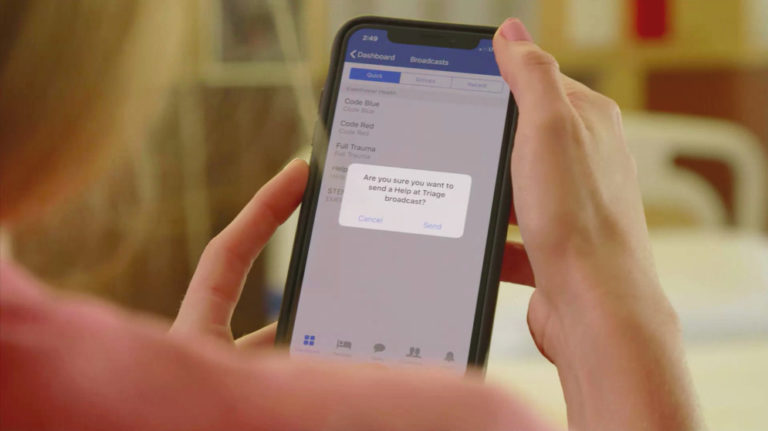Around this time each year, medical writers like to speculate what they think the next big trend in medicine might be. For example, people heralded 2017 as the “year of artificial intelligence,” while robotics and telemedicine have also earned time in the spotlight for the promises they brought and continue to bring for care delivery.
And rightly so—each of those advancements meets critical industry needs head-on in a way that helps humans do their jobs even better. That’s why the next big medical breakthrough may just be something that seems unassuming, but in reality, offers transformative change: Hospital alerting.
The Case for Improved Alerting
The need has been building up for quite some time. Every day, doctors and nurses get interrupted by pings, beeps and buzzes that come from multiple devices—from pagers and phones to heart monitors and other machines at the patient’s bedside.
The cacophony feeds an epidemic of alarm fatigue, and ultimately physician burnout, which affects an estimated 1 in 3 clinicians. In 2019, buzz about burnout hit an all-time high, with many thought leaders wondering how to solve the monumental problem of clinicians getting too many alerts, sirens and alarms, too often.
Even medical groups have emphasized the seriousness of the issue, such as the Joint Commission, which has historically issued calls for standardization for many years, including in its most recent 2019 National Patient Safety Goals.
Now at its precipice, clinician burnout needs solutions not only for clinicians’ mental health, but for the operational health of hospitals, as well as patients themselves, since the consequences of alarm fatigue can be deadly: One study showed that more than 200 deaths over a 5-year period were caused by failure to respond to alarms.
Indeed, while 2019 was a banner year for the problem, 2020 will no doubt be one for the solution. That’s where smarter alerting comes in.
Emerging Trends in Hospital Alarms & Alerts
Very recently, the American Medical Association offered actionable solutions to help curb alarm fatigue and clinician burnout. While the group’s suggestions centered on improvements to EHRs and related processes, many tips have more universal applications and mark continued interest in helping doctors cut back on screen time for the sake of more facetime with patients.
For example, establishing a task force can help refine alerting strategies and protocols with an eye for prioritizing the most important alerts while cutting out the ones doctors don’t need to see. The physician group Reliant Medical Group did this to great success, with a seven-member team that meets weekly to cultivate new ideas to keep fatigue at bay. Similarly, hospitals have ramped-up efforts to delegate more technical and high-click tasks like inbox or basket review back to assistants or others more suited for those responsibilities.
Of course, reducing alerts is only half the battle—and some alarms, like telemetry alerts or codes, need urgent attention. In those cases, the sound and scale of the alarm may matter just as much as its substance or recipient: After all, hearing the same beep repeatedly not only becomes monotonous and bothersome, but increases the risk that clinicians will get immune to the sound and not notice when it rings.
Some hospitals, such as Boston Medical Center (BMC), have worked to lessen the audial impact of alerts and alarms by changing protocol to reduce decibels. BMC also individualized default heart rate settings so that alarms wouldn’t go off unnecessarily. Others have employed more creative solutions—like evolving from high-decibel sirens to softer whistles and songs that still convey urgency without the ear-splitting noise.
CC&C’s Role in Revamping Alarms
In all this, clinical communication and collaboration (CC&C) tools can go a long way in system-level alarm standardization. And in fact, turning department-wide alarms that everyone hears into device-based alerts that selected clinicians hear is a proven way to combat alarm fatigue.
But even then, it’s important to ensure that any CC&C tool effectively reduces fatigue so that when clinicians get an alert on their phone, it’s something that 1) they truly need to see, and 2) they can immediately assess without undue workflow disruption.
For our part, we’re excited about the upcoming launch of the 19.3 release to MH-CURE®, which includes stand-out features that aim to do exactly that. As part of the update, users will be able to:
- Customize alert types with unique sounds for each one, such as tones that indicate a heart monitor versus a code red. With that feature, clinicians can understand the urgency of the alert just by its sound—without needing to reach for their phone every time to see it.
- Respond directly within the alert notification banner to accept, escalate or call someone, without having to open the app.
- View the full alert history to track the status of alerts for more complete context.
- Have inbound alerts automatically escalate to another user if the intended recipient is offline.
As we look forward to providing those features and many more in our 19.3 release this fall, we’re excited to help hospitals combat alarm fatigue—especially during what might very well become the Year of Alerting.





